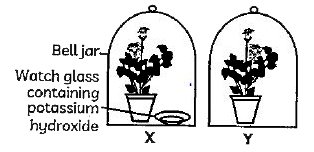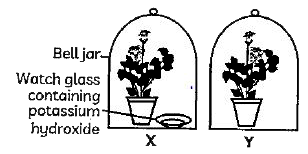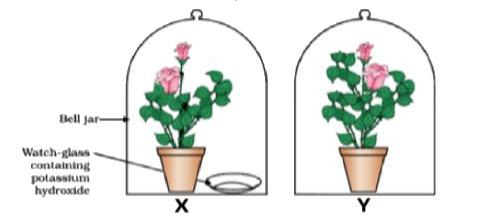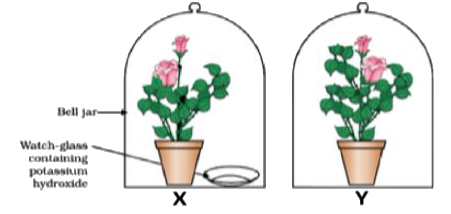Small populations of three types of animals X, Y and Z were kept in captivity. Plenty of plants were present in that area. The change in the population of these organisms with time was plotted in the graph as shown here.

Which of the following conclusion is incorrect regarding their eating habits?
X could be a carnivore that feeds on Z but not on Y.
Both X and Y could be herbivores and Z could be a carnivore whose population declines as it does not prey on both X and Y.
If X and Y are herbivores, then X has higher reproductive potential than Y.
None of these
The correct Answer is:D
None of these
Related Playlists
Similar Practice Problems
- Question 1 - Select One
The pre-historic man preferred this area as three of his primary needs-water, raw material for tool making and game in the thick jungles, were available here in plenty. Mr. Sharma found sites on top of hills where huge boulders have been cut flat. These flat rocks were found in the round formation. Probably they sat on these and there was a fire in the middle. It was also a site where the tools were made. It was like a national pastime. They made tools to throw at animals. There was little chance of killing them with one tool. Mr. Sharma says there are strong chances of finding fossils in the area.
Which of the following does not describe the activities of the man as mentioned in the passage?AHunting animalsBLighting firesCCutting stonesDCultivating land. - Question 1 - Select One
Instructions
Read the following passage and answer the questions given after it. Passage:
By the 19205 the improvements in street lighting, domestic lighting and a surge in cofiee houses - which were sometimes open all night — was complete. As the night became a place for legitimate activity, the length of time people could dedicate to rest dwindled.” Evening's Empire puts forward an account of how this happened. "Associations with night before the 17th Century were not good,” it says. “The night was a place populated by people of disrepute - criminals, prostitutes and drunks. Even the wealthy, who could afford candlelight, had better things to spend their money on. There was no prestige or social value associated with staying up all night."
That changed in the wake of the Reformation and the counter- Reformation. Protestants and Catholics became accustomed to holding secret services at night. If earlier the night had belonged to reprobates, now respectable people became accustomed to exploiting the hours of darkness. This trend migrated to the social sphere too, but only for those who could afford to live by candlelight. With the advent of street lighting, however, socializing at night began to filter down through the classes.
In 1667, Paris became the first city in the world to light its streets, using wax candles in glass lamps. It was followed by Lille in the same year and Amsterdam two years later, where a much more efficient oilpowered lamp was developed. A small city like Leipzig in central
Germany employed 100 men to tend to 700 lamps. London didn‘t join their ranks until 1684 but by the end of the century, more than 50 of Europe's major tovms and cities were lit at night. Night became fashionable and spending hours lying in bed was considered a waste of time.
"People were becoming increasingly time-conscious and sensitive to efficiency, certainly before the 19th Century," says Roger Ekirch. "But the industrial revolution intensified that attitude by leaps and bounds." Strong evidence of this shifting attitude is contained in a medical journal from 1829 which urged parents to force their children out of a pattern of first and second sleep. "If no disease or accident there intervene, they will need no further repose than that obtained in their first sleep.”
Today, most people seem to have adapted quite well to the eight-hour sleep, but Ekirch believes many sleeping problems may have roots in the human body’s natural preference for segmented sleep as well as the ubiquity of artificial light. This could be the root of a condition called sleep maintenance insomnia, where people wake during the night and have trouble getting back to sleep, he suggests. The condition first appears in literature at the end of the 19th Century, at the same time as accounts of segmented sleep disappear.
Which of the following is NOT true regarding the nights in 19205 in Europe?AMostly people of disrepute haunted the streets at night.BNights became a time for legitimate activityCProtestants and Catholics started holding secret services at night.DSocializing at night became common among all classes. - Question 1 - Select One
Directions (16-20) : Read the following passage and answer the questions given after it.
By the 1920s the improvements in street lighting, domestic lighting and a surge in coffee houses - which were sometimes open all night - was complete. As the night became a place for legitimate activity, the length of time people could dedicate to rest dwindled. Evening.s Empire puts forward an account of how this happened. "Associations with night before the 17th Century were not good," it says. "The night was a place populated by people of disrepute - criminals, prostitutes and drunks. Even the wealthy, who could afford candlelight, had better things to spend their money on. There was no prestige or social value associated with staying up all night."
That changed in the wake of the Reformation and the counter-Reformation. Protestants and Catholics became accustomed to holding secret services at night. If earlier the night had belonged to reprobates, now respectable people became accustomed to exploiting the hours of darkness. This trend migrated to the social sphere too, but only for those who could afford to live by candlelight. With the advent of street lighting, however, socializing at night began to filter down through the classes.
In 1667, Paris became the first city in the world to light its streets, using wax candles in glass lamps. It was followed by Lille in the same year and Amsterdam two years later, where a much more efficient oil-powered lamp was developed. A small city like Leipzing in central Germany employed 100 men to tend to 700 lamps. London didn.t join their ranks until 1684 but by the end of the century, more than 50 of Europe.s major towns and cities were lit at night. Night became fashionable and spending hours lying in bed was considered a waste of time.
"People were becoming increasingly time-conscious and sensitive to efficiency, certainly before the 19th Century," says Roger Ekirch. "But the industrial revolution intensified that attitude by leaps and bounds:" Strong evidence of this shifting attitude is contained in a medical journal from 1829 which urged parents to force their children out of a pattern of first and second sleep. "If no disease or it accident there intervene, they will need no further repose than that obtained in their first sleep."
Today, most people seem, to have adapted quite well to the eight-hour sleep, but Ekirch believes many sleeping problems may have roots in the human body.s natural preference for segmented sleep as well as the ubiquity light. This could be the root of a condition called sleep maintenance insomnia, where people wake during the night and have trouble getting back to sleep, he suggests. The condition first appears in literature at the end of the 19th Century, at the same time as accounts of segmented sleep disappear.
Which of the following is NOT true regarding the nights in 1920s in Europe?AProtestants and Catholics started holding secret services at nightBSocializing at night became common among all classes.CNights became a time for legitimate activity.DMostly people of disrepute haunted the streets at night. - Question 1 - Select One
Directions : Based on reading of the passage given below, answer the next two questions by selecting the most appropriate option.
The city of Dholavira was located on Khadir Beyt in the Rann of Kutch, where there was fresh water and fertile soil. Unlike some of the other Harappan cities, which were divided into two parts. Dholavira was divided Into three parts and each part was surrounded with massive stone walls, with entrances through gateways.
There was also a large open area In the settlement, where public ceremonies could beheld.
Other finds include large letters of the Harappan script that were carved out of white stone and perhaps inlaid In wood. 'This is an unique find as generally Harappan writing has been found on small objects such as seals.
The city of Lothal stood beside a tributary of the Sabarmati, in Gujarat, close to the Gulf of Kharnbat. lt was situated near areas where raw materials such as semi-precious stones were easily available.
'This was an important centre for making objects out of stone, shell and metal. There was also a store house in the city. Many seals and sealing, (the impression of seals on clay) were found in this storehouse.
Source: Our Past I
Which one of the following statements regarding Harappan site of Gujarat is incorrect based on the passage?AThe city of Lothal was located beside a tributary of the SabarmatlBThis was an Important centre for making objects out of stone, shell and metalCThere was no any evidence of store house In the cityDLethal was situated near areas where raw materials were available - Question 1 - Select One
Long ago men spent most of their time looking for food. They ate anything they could find. Some lived mostly on plants. They ate the fruit, stems, and leaves of some plants and the roots of others. When food was scarce, they ate the bark of trees. If they were lucky, they would find a bird's nest with eggs. People who lived near the water ate fish or anything that washed ashore, even rotten whales. Some people also ate insects and small animals like lizards that were easy to kill.
Later, men learned to make weapons. With weapons, they could kill larger animals for meat. These early people had big appetites. If they killed an animal, they would drink the blood, eat the meat, and chew the bones. When they finished the meal, there was nothing left.
At first men wandered from place to place to find their food. But when they began to grow plants, they stayed in one place and ate what they could grow. They tamed animals, trained them to work, and killed them for meat, Life was a little better then, but there was still not much variety in their meals. Day after day people ate the same food,
Gradually men began to travel greater distances. The explorers who sailed unknown seas found new lands. And in these lands they found new food and spices and took them back home.
The Portuguese who sailed around the stormy Cape of Good Hope to reach China took back "Chinese apples", the fruit we call oranges today. Later, Portuguese colonists carried orange seeds to Brazil. From Brazil oranges were brought to California, the first place to grow oranges in the United States. Peaches and melons also came from China. So did a new drink, tea.
Which of the following titles best expresses the main idea of the passage ?AEat Healthy FoodBThe Search for FoodCThe Foods We EatDGreat Food Regions of the World - Question 1 - Select One
Case : The Figure shown below represents an activity to prove the requirements for photosynthesis. During this activity, two healthy potted plants were kept in the dark for 72 hours. After 72 hours, KOH is kept in the watch glass in setup X and 'not in setup Y. Both these setups are air tight and have been kept in light for 6 hours. Then, lodine Test is performed with one leaf from each of the two plants X and Y.

Which of the following statements shows the correct results of lodine Test performed on the leaf from plant X and Y respectively?ABlue - black colour would be obtained on the leaf of plant X and no change in colour on leaf of plant Y.BBlue - black colour would be obtained on the leaf of plant Y and no change in colour on leaf of plant X.CRed colour would be obtained on the leaf of plant X and brown colour on the leaf of plant Y.DRed colour would be obtained on the leaf of plant Y and brown colour on the leaf of plant X. - Question 1 - Select One
Case : The Figure shown below represents an activity to prove the requirements for photosynthesis. During this activity, two healthy potted plants were kept in the dark for 72 hours. After 72 hours, KOH is kept in the watch glass in setup X and 'not in setup Y. Both these setups are air tight and have been kept in light for 6 hours. Then, lodine Test is performed with one leaf from each of the two plants X and Y.

Which of the following steps can be followed for making the apparatus air tight?
(I) placing the plants on glass plate
(II) using a suction pump.
(III) applying aseline to seal the bottom of jar.
(IV) creating vacuumA(I) and (III)B(II) and (III)C(I) and (IV)D(II) and (IV)
Similar Questions
In a study, water samples of Yamuna river were collected from four different cities (W, X, Y and Z) to check the presence of Coliform bacteria. The result obtained was plotted in the given graph.
Select the incorrect statement regarding this.
 View Solution
View SolutionThe Figure shown below represents an activity to prove the requirements for photosynthesis. During this activity, two healthy potted plants were kept in the dark for 72 hours. After 72 hours, KOH is kept in the watch glass in setup X and not in setup Y. Both these setups are air tight and have been kept in light for 6 hours. Then, Iodine Test is performed with one leaf from each of the two plants X and Y.

Which of the following statements shows the correct results of Iodine Test performed on the leaf from plant X and Y respectively?View SolutionThe Figure shown below represents an activity to prove the requirements for photosynthesis. During this activity, two healthy potted plants were kept in the dark for 72 hours. After 72 hours, KOH is kept in the watch glass in setup X and not in setup Y. Both these setups are air tight and have been kept in light for 6 hours. Then, Iodine Test is performed with one leaf from each of the two plants X and Y.

Which of the following steps can be followed for making the apparatus air tight?
i. placing the plants on glass plate
ii. using a suction pump.
iii. applying aseline to seal the bottom of jar.
iv. creating vacuumView Solution

